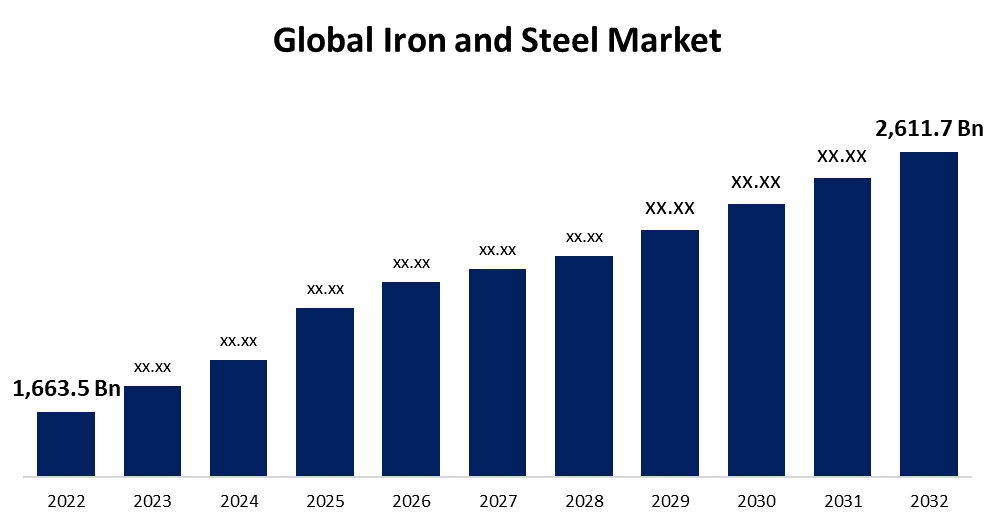Global Iron and Steel Market Size To Worth USD 25.9 Billion by 2032 | CAGR of 4.6 %.
Category: Chemicals & MaterialsGlobal Iron and Steel Market Size To Worth USD 25.9 Billion By 2032
According to a research report published by Spherical Insights & Consulting, the Global Iron and Steel Market Size to grow from USD 1,663.5 Billion in 2022 to USD 2,611.7 Billion by 2032, at a Compound Annual Growth Rate (CAGR) of 4.6 % during the forecast period.

Get more details on this report -
Browse key industry insights spread across 200 pages with 110 Market data tables and figures & charts from the report on "Global Iron and Steel Market Size, Share, and COVID-19 Impact By Product (Flat Products, Long Products, Tubular Products, Semi-finished Products, Others), By Application (Building & Construction, Automotive & Transportation, Heavy Industry, Consumer Goods, Others), by Region (North America, Europe, Asia-Pacific, Latin America, Middle East, and Africa), Analysis and Forecast 2022 – 2032."Get Detailed Report Description Here: https://www.sphericalinsights.com/reports/iron-and-steel-market
The demand for iron and steel is significantly influenced by a number of different businesses, including those in the industrial, automotive, infrastructure, and construction sectors. Economic growth in countries or regions frequently results in increased demand for steel products. The supply is based on the availability of iron ore and other raw materials as well as the production capability of the steel mills. The iron and steel market is dominated by a small number of large players, including companies from China, India, Japan, and other countries. Both the initial manufacture of steel from iron ore and the production of iron from iron ore are under the control of these companies' integrated steel mills.
COVID 19 Impact
During the early stages of the pandemic, many governments placed bans and other measures to stop the virus from spreading. As a result, the demand for steel decreased across a variety of industries, including manufacturing, construction, and the car industry. The closure of factories that made vehicles and structures was a contributing factor in the decline in the consumption of steel. The outbreak disrupted global supply networks, which affected the availability of raw materials and caused logistical problems. Transport restrictions, border closures, and a lack of labor in some places made it difficult to move the iron ore and other raw materials needed to make steel. The unpredictable nature of the epidemic exacerbated the price volatility in the iron and steel industry. The pandemic made clear how important environmental and sustainability issues are. Some steel businesses increased their efforts to adopt greener technology and reduce their carbon footprint as part of their long-term goals.
This industry is a big consumer of iron and steel because these commodities are used in the construction of buildings, bridges, highways, and other infrastructure projects. Rapid urbanization and industrialisation may lead to an increase in demand for building supplies. Steel is widely utilized in the manufacturing and automotive industries to make a wide range of products, including automobiles, equipment, appliances, and more. The demand from these sectors could encourage the growth of the iron and steel market. Because of the increased demand for infrastructure, housing, and consumer goods as societies become more urbanized and industrialized, iron and steel demand tends to rise. The iron and steel industry is global, and production typically happens in one location while raw materials are purchased.
The iron and steel industry has repeatedly been affected by the overcapacity issue, which occurs when production capacity exceeds demand. The intense worldwide competition and pricing pressure that results may have an effect on the profitability of enterprises in the sector. Steel is frequently manufactured through energy-intensive methods that simultaneously generate other pollutants and greenhouse gases. Because the sector must adhere to strict environmental regulations and reduce its carbon footprint, it is challenging to adopt cleaner and more sustainable production methods. The price of raw materials like iron ore and coking coal might fluctuate, which can impact the cost of producing steel. Geopolitical factors that affect the availability of these commodities or disruptions in the supply chain could cause issues for the industry.
Product Insights
Flat products segment holds the largest market share over the forecast period
On the basis of product, the global iron and steel market is segmented into Flat Products, Long Products, Tubular Products, Semi-finished Products, Others. Among these, flat products segment holds the largest market share over the forecast period. Flat steel products are commonly used in the construction sector, particularly for cladding, roofing, and building framework. With the expansion of infrastructure and urbanization projects worldwide, the demand for flat steel products has increased. Flat steel is used to construct household equipment such as refrigerators, ovens, and washing machines. The growth of the consumer goods market has led to a rise in the demand for these commodities. The automotive sector is a key user of flat steel products for the construction of automobile bodywork, chassis parts, and other elements. The growth of the automotive industry has raised demand for high-quality, lightweight, and durable flat steel components.
Application Insights
Building and construction segment is dominating the market over the forecast period
Based on the application, the global iron and steel market is segmented into Building & Construction, Automotive & Transportation, Heavy Industry, Consumer Goods, Others. Among these, building and construction segment is dominating the market over the forecast period. Globally, urbanization is booming, which has increased demand for new buildings, infrastructure, and housing. Steel is used in the construction of skyscrapers, bridges, roadways, airports, and other important infrastructure projects. Population growth is a major factor in the demand for residential and commercial space, which increases construction activity and the use of steel in structural components. Warehouses, industrial buildings, and commercial constructions usually require spacious interiors and strong structural support. The benefit of steel is that it can span a large area without the need for many columns or supports. Public policy and private finance for infrastructure projects like ports, transit networks, and urban redevelopment may lead to an increase in the demand for steel in the construction industry.
Regional Insights
North America is dominating the market over the forecast period

Get more details on this report -
North America holds the largest market share and is dominating the market over the forecast period. The automotive industry in North America is a significant consumer of steel. The body, chassis, and other structural components of automobiles, as well as other parts, are frequently made of steel during the manufacturing process. In North America, steel is frequently utilized in the construction industry for many different things, including the construction of buildings, bridges, and infrastructure projects. The demand for steel goods in the building industry is impacted by trends in urbanization and infrastructure growth. Economic cycles can affect the iron and steel market in North America, just like they can in other regions of the world. The demand for commodities made of steel may be impacted by changes in the economy and industrial operations.
Asia Pacific is witnessing the fastest market growth over the forecast period. The automotive industry in North America is a significant consumer of steel. The body, chassis, and other structural components of automobiles, as well as other parts, are frequently made of steel during the manufacturing process. In North America, steel is frequently utilized in the construction industry for many different things, including the construction of buildings, bridges, and infrastructure projects. The demand for steel goods in the building industry is impacted by trends in urbanization and infrastructure growth. Economic cycles can affect the iron and steel market in North America, just like they can in other regions of the world. The demand for commodities made of steel may be impacted by changes in the economy and industrial operations.
Market Segment
This study forecasts revenue at global, regional, and country levels from 2019 to 2032. Spherical Insights has segmented the global Iron and Steel Market based on the below-mentioned segments:
Iron and Steel Market, Product Analysis
- Flat Products
- Long Products
- Tubular Products
- Semi-finished Products
- Others
Iron and Steel Market, Application Analysis
- Building & Construction
- Automotive & Transportation
- Heavy Industry
- Consumer Goods
- Others
Iron and Steel Market, Regional Analysis
- North America
- US
- Canada
- Mexico
- Europe
- Germany
- Uk
- France
- Italy
- Spain
- Russia
- Rest of Europe
- Asia Pacific
- China
- Japan
- India
- South Korea
- Australia
- Rest of Asia Pacific
- South America
- Brazil
- Argentina
- Rest of South America
- Middle East & Africa
- UAE
- Saudi Arabia
- Qatar
- South Africa
- Rest of Middle East & Africa
About the Spherical Insights & Consulting
Spherical Insights & Consulting is a market research and consulting firm which provides actionable market research study, quantitative forecasting and trends analysis provides forward-looking insight especially designed for decision makers and aids ROI.
Which is catering to different industry such as financial sectors, industrial sectors, government organizations, universities, non-profits and corporations. The company's mission is to work with businesses to achieve business objectives and maintain strategic improvements.
CONTACT US:
For More Information on Your Target Market, Please Contact Us Below:
Phone: +1 303 800 4326 (the U.S.)
Phone: +91 90289 24100 (APAC)
Email: inquiry@sphericalinsights.com, sales@sphericalinsights.com
Contact Us: https://www.sphericalinsights.com/contact-us
Follow Us: LinkedIn | Facebook | Twitter
Global Iron and Steel Market Size Overview 2022 - 2032: Watch Video By YouTube
Need help to buy this report?